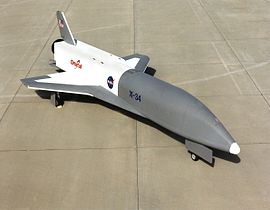 The X-34 on the tarmac | |
| Function | Unmanned re-usable spaceplane |
|---|---|
| Manufacturer | Orbital Sciences Corporation |
| Country of origin | United States |
| Size | |
| Height | 11.5 ft[1] (3.5 m) |
| Diameter | n/a |
| Length | 58.3 ft[1] (17.77 m) |
| Wingspan | 27.7 ft[1] (8.44 m) |
| Mass | 18,000 lb[1] (8,200 kg) |
| Stages | 1 |
| Capacity | |
| Launch history | |
| Status | Cancelled (March, 2001) |
| Launch sites | Dryden Flight Research Center, Kennedy Space Center |
| Total launches | 0 |
| First stage - X-34 | |
| Engines | 1 Marshall-designed Fastrac engine[1] |
| Thrust | 60,000 lbf[1] (270 kN) |
| Burn time | |
| Fuel | LOX/kerosene |
The Orbital Sciences X-34 was intended to be a low-cost testbed for demonstrating "key technologies" which could be integrated into the Reusable Launch Vehicle program. It was intended to be an autonomous pilotless craft powered by a 'Fastrac' liquid-propellant rocket engine, capable of reaching Mach 8, and performing 25 test flights per year.
The X-34 began as a program for a suborbital reusable-rocket technology demonstrator. In early 2001, the first flight vehicle was near completion, but the program was ended due to budget concerns. Up to this point, the project had encompassed spending of just under $112 million: $85.7M from the original contract with designer Orbital Sciences, $16M from NASA and various government agencies for testing, and an additional $10M for Orbital Sciences to adapt its L-1011 carrier to accommodate the X-34. The program was officially canceled by NASA on March 31, 2001.[2] The unpowered prototype had been used only for towing and captive flight tests when the project was canceled.
The two demonstrators remain in storage at Edwards Air Force Base.[3] When they were temporarily moved to Mojave, California in late 2010, there was some speculation that they might be restored to flight status.[4]
See also[]
- List of experimental aircraft
- Cygnus (spacecraft)
- Lockheed Martin X-33
- Prometheus (spacecraft) (CCdev)
- Sierra Nevada Dream Chaser (CCdev)
References[]
- ↑ 1.0 1.1 1.2 1.3 1.4 1.5 Wikisource:X-34: Demonstrating Reusable Launch Vehicle Technologies
- ↑ https://www.nasa.gov/centers/armstrong/news/FactSheets/FS-060-DFRC.html
- ↑ Orbital Sciences Corporation X-34 - 2007 photo. Airliners.net
- ↑ http://www.flightglobal.com/articles/2010/11/19/349997/photos-nasa-moves-x-34s-out-of-storage-considers-return-to-flight.html
External links[]
Wikimedia Commons has media related to Category:Orbital Sciences X-34. USAF / Joint Service experimental aircraft (X-plane) designations since 19411–25 26–50 50– See also 1 Not assigned.All or a portion of this article consists of text from Wikipedia, and is therefore Creative Commons Licensed under GFDL.
The original article can be found at Orbital Sciences X-34 and the edit history here.